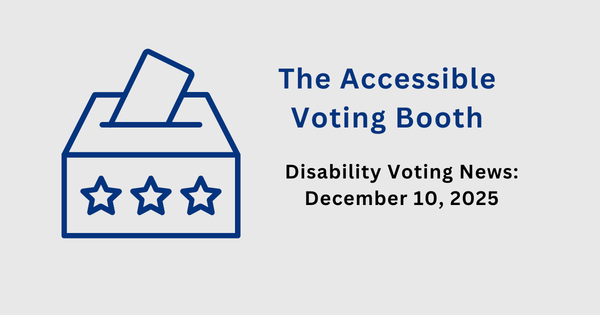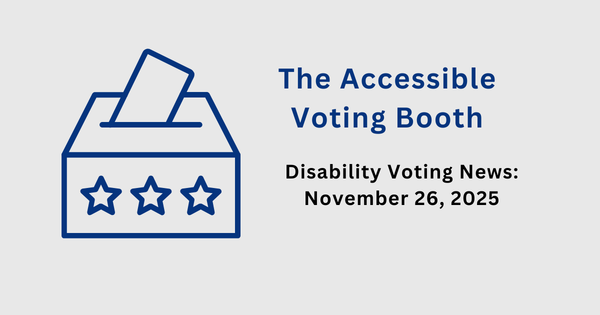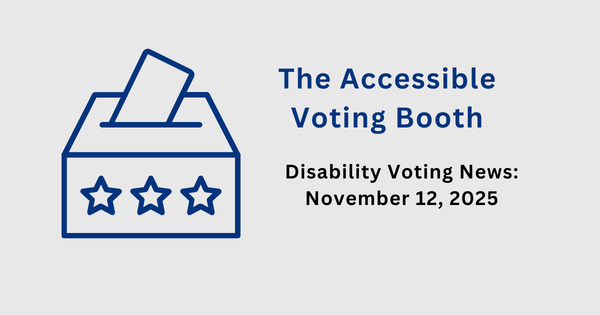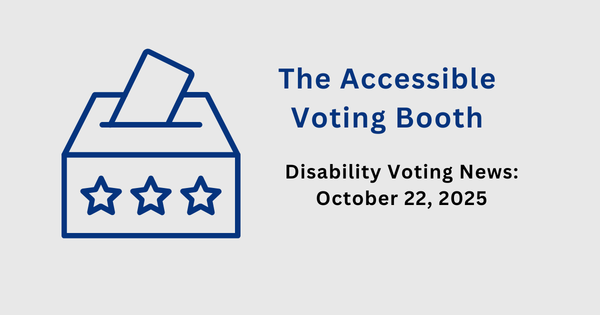Disability Voting News: May 21, 2025
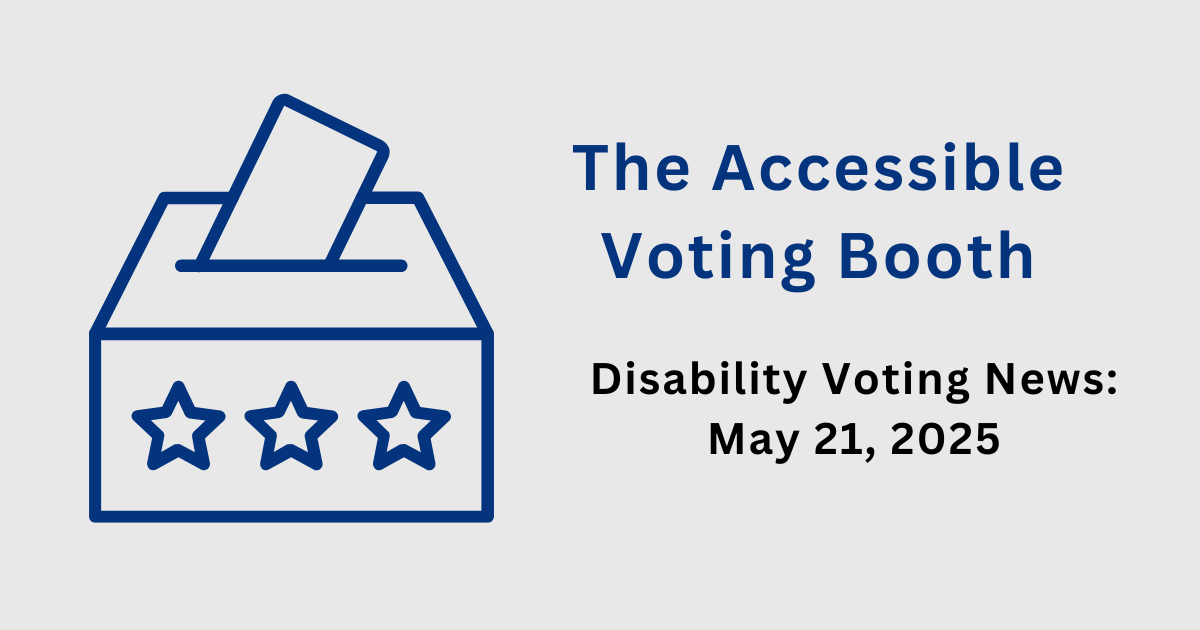
Welcome to the Accessible Voting Booth for May 21, 2025. This week, I didn’t have time to analyze state-level voting legislation because I was busy with the National Voting Access Summit!
Below, I’m going to give a little summary of each session of the summit, which has been recorded in English and Spanish and will be available soon for playback. Before we get into that, a few announcements. First, there will be no Accessible Voting Booth next week. I’ll be back on June 4th. Producing this newsletter every week is fun, but it is a LOT, and I need a moment to catch my breath!
Next Wednesday, I’ll be participating in the Poll Audit Results Briefing that you’ll read about below, and then on June 4th, I’ll be back with a summary of the Detroit poll audit results (which I’ve been involved in preparing for six months) and state-level voting updates.
Before we get into the Summit summary, here are two events to put on your radar:
Detroit Disability Power: Election Integrity Briefing: Poll Audit Results
Join Detroit Disability Power on Wednesday, May 28, 2025 at 11:00 a.m. Eastern for a critical briefing on our recent poll audit findings regarding ADA compliance in Southeast Michigan polling locations. Their comprehensive poll audit reveals that only 13% of polling locations in Southeast Michigan are fully ADA compliant. This briefing will provide county clerks, election officials, voting rights organizations, and press with detailed findings of ADA compliance issues across polling locations, analysis of specific accessibility barriers identified, recommended solutions and best practices, and opportunities for collaboration to improve accessibility
ASL provided. Register for the briefing.
Disability Victory: Introduction to Lobbying
Join Disability Victory on Thursday, May 29 at 2:00 PM Eastern for Introduction to Lobbying. What is lobbying, who does it, and how can it make you a better lobbyist? Rebecca Lamorte is an experienced lobbyist who will break down how lobbying can influence the legislative process. You'll learn the basics of lobbying and how different groups can engage in lobbying, debunk myths about the practice, hear examples of how lobbying has been used to advance disability advocacy, and learn techniques and best practices.
This training is free and will have CART captioning and American Sign Language (ASL) interpretation. You can request additional accommodations upon registration or by emailing hello@disabilityvictory.org. Register for Introduction to Lobbying.
Without further ado, here’s my writeup of the National Voter Access Summit!
A Historical Overview and trends of Voting Accessibility in the United States
Rutgers University professors Doug Kruse and Lisa Schur kicked off the summit with a preview of their report on turnout for voters with disabilities in the November 2024 election. Their full report will be out over the summer, so I won’t spoil it all for you. They found that there is still a disability voter turnout gap, but that gap continues to narrow over subsequent elections–Doug and Lisa have been evaluating disability voter turnout since 2012, so they have a great longitudinal view of disability voter turnout for more than a decade.
They found better turnout results in states that have more expansive access to vote by mail, such as states with universal vote by mail. Their findings reaffirm that vote by mail provides means for millions of voters with disabilities to exercise their right to vote in a way that accommodates their disabilities. Of course, this isn’t perfect, as vote by mail is not as accessible (and sometimes completely inaccessible) for people who are blind or have low vision, especially in states that don’t offer electronic ballots for voters who need to use assistive technology to read and mark their ballots.
Their data shows that the accessibility of voting continues to be a problem that suppresses disability voter turnout. However, difficulty in voting in polling places for voters with disabilities has declined markedly from 2012 to 2020, from 30% to 18%. They attributed half of the decline in difficulties in voting to improvements in making polling places more accessible–this data should motivate more election officials to improve polling place accessibility, as it has a measurable impact over time.
Doug and Lisa’s presentation was fantastic, and I can’t wait to provide more detailed analysis when their report comes out later this year. They’re also working with the U.S. Election Assistance Commission on a report on how voters with disabilities use election technologies including voting equipment, e-pollbooks, voter registration pages, and more, so I’m eager to see those results the summer. I’ll be sure to update you here when they’re released!
Commitment to Accessible Elections by the U.S. Election Assistance Commission
Next, we heard from U.S. Election Assistance Commissioner Tom Hicks and EAC Subject Matter Expert Ben Jackson. They gave an overview of the EAC’s role in making elections more accessible by providing guidance to election officials and supporting voters with disabilities to register to vote and understand their options for accessible voting.
Ben Jackson gave an overview of the Election Administration and Voting Survey, or EAVS, which is a comprehensive survey of election administration that is distributed to election officials. EAVS includes important questions around voting accessibility. During the 2022 survey, they reported that 27 states indicated they allowed voters with disabilities to receive their ballots electronically, and over 82,000 voters registered at disability services offices. Their data on the 2024 election will be available in June with additional questions on electronic ballot return, state laws around voting and guardianship, and curbside voting. They also shared about the 2024 EAC Clearinghouse Award winners for accessibility, which I covered in a previous issue of The Accessible Voting Booth.
The EAC shared comprehensive new resources for election officials, available on their website.
From Coast to Coast: A Conversation Regarding Best Practices Conducting Poll Audits Across the Country
During this session led by Michelle Bishop (the Manager for Voter Access and Engagement at the National Disability Rights Network), staff from Protection and Advocacy agencies and centers for independent living around the country discussed how they monitor polling places for accessibility and work with election officials to address access barriers.
This panel showcased how disability rights organizations work in their different state contexts to monitor polling places and included staff from Disability Rights West Virginia, Disability Law Center of Massachusetts, and Center for Independence for the Disabled in New York. Their access to the polling place really varies depending on the state. In New York City, CIDNY staff and volunteers not only have full access to the polling place to monitor both exterior and interior accessibility, but they can even take pictures inside the polling place of accessibility barriers. In West Virginia, auditors only have access to the outside of the polling place, and they have experienced resistance from the state when trying to gain access inside of polling places.
Interestingly enough, Taniua Hardy of Disability Rights West Virginia noted that election officials in small, rural areas with fewer resources have made a greater effort to improve polling place accessibility than election officials in larger counties with more resources. The panelists talked about the differences in auditing more urban polling places versus rural locations, and how their focus shifts based on whether voters are more likely to use cars or public transportation. They also talked about best practices around accessing polling places and documenting access barriers, and how pictures (when allowed) can provide critically important data on access barriers.
Reflecting on their relationships with election officials, all of the panelists have had generally positive relationships with local and state election officials, and they noted that this was critical for both gaining access to audit polling places and addressing the access barriers that their observers find. They all value collaborative relationships with election officials and reinforce having a positive tone and approaching election officials as partners. When Michelle asked all of the panelists about one thing that they want election officials to know about their work, they reiterated that they are here to help and to collaborate, and that when we bake in accessibility and disability inclusion from the start, it improves our elections.
I hope more election officials understand that Protection and Advocacy agencies and other organizations observing polling places are here to help them and serve as resources on voting accessibility.
Creating Accessible Poll Audit Programs: Protecting the Disability Vote in Your Community
In this final session for day one, Eric Welsby and Kenia Flores of Detroit Disability Power talked about the accessibility audits that they have conducted in Michigan since 2018. Through my role at the Carter Center, I’ve supported DDP’s audits since 2022, when they audited 261 polling places and found that only 16% were fully accessible.
I’m not going to go into too much detail on this session, because DDP will be releasing their report on polling place accessibility in the 2024 elections next Wednesday, and I’ll talk about that more on June 4th. But in the meantime, register for DDP’s briefing on the results next Wednesday!
DDP shared how and why they conduct polling place audits and how this information empowers them to sit down with election officials, discuss accessibility barriers, and make recommendations for improving voting accessibility. They walked through the process of conducting an audit, including understanding state laws around polling place observation and creating a plan around voting audits, training volunteers to observe, and the methodology for conducting audits.
For more detail on how to conduct your own audits, you can download a comprehensive toolkit that provides worksheets, planning documents, the observation questionnaire, and more. This toolkit is prepared by the National Polling Access Audit Coalition.
Election Protection Initiatives Include Accessibility, Too
Day two of the summit kicked off with a stellar panel facilitated by former Civic Tennessee staffer Steven Adelson and featuring members of election protection organizations: Kathy Jones of League of Women Voters (LWV) Alabama, Shira Roza of Promote the Vote, and Adam Altendorf of Organize Tennessee.
The organizers reflected on how they incorporate accessibility into “mainstream” election protection work. Each one emphasized the importance of not speaking for the disability community, but instead ensuring that people with disabilities are fully included in their work through partnering with disability rights organizations and working with volunteers with disabilities. Their election protection work took different forms. Kathy of LWV Alabama spoke about how the organization works with groups like the National Federation of the Blind to testify in the legislature. This has been a particularly important tactic, particularly when Alabama passed a bill to criminalize assistance with absentee ballots. LWV Alabama joined in coalition with disability rights and civil rights groups to bring a lawsuit challenging the bill.
Adam Altendorf of Organize Tennessee came to the conversation equipped with some really helpful data to back up his arguments: one in six Organize Tennessee volunteers has a disability, and he said that building relationships with those volunteers is essential for truly understanding the challenges that voters with disabilities face. Last year, their poll observer program visited 200 locations across the state in all counties. Organize Tennessee does training with a number of partner organizations and shares how their voter protection work impacts people with disabilities and what the law requires in terms of accommodating people with disabilities. They also conducted training focused on language access with absentee ballots. Adam said that 50 percent of the vote in Tennessee comes in early, and one of the biggest challenges they face is the frequent movement of polling places: many polling locations have been moved from public locations to churches, which are regularly exempt from the Americans with Disabilities Act, negatively impacting accessibility. They continue to address accessibility through their robust observer program.
Promote the Vote works across Michigan and trains volunteers and partner organizations across the state. They ensure that they train their volunteers on how to address accessibility barriers that they observe–many issues are minor and can be remediated with a simple conversation with poll workers, like improper setup of accessible voting systems. That way, they can fix these issues in real time and escalate more complex issues to lawyers for assistance.
There was so much wisdom packed into this panel, and I really appreciated how much these organizers centered their volunteers and partners with disabilities. I can’t pack every great piece of advice into this short summary, so definitely watch the recording when it is made available!
Storytelling and Engaging with the Media
In this session led by Meier Galblum Haigh of the Disability Culture Lab, we heard from Shruti Rajkumar, a disabled journalist, and Susan Lydick, a member of REV UP Virginia, on how advocates can effectively use storytelling to advance their work and engage with journalists. This session was honestly more helpful than some media training sessions I’ve attended, and just like with other sessions, there’s more than I could possibly include in this brief summary.
Shruti shared what they look for when writing a story: something that brings a new lens to a topic, something that has a strong and timely news angle because as a journalist, they not only have to tell compelling stories, but find angles that match what their outlet is looking for.
Both Shruti and Susan emphasized that good preparation can help you find success in landing your story in the media. Keep a list of people who are willing to talk to the media on the subject you’re trying to pitch. Do your research on the reporter you’re reaching out to and the outlet that you’re trying to pitch, and tailor your pitch to that reporter and outlet. Use a compelling email subject line like a headline to grab attention. Build lasting relationships and connections with reporters, and don’t burn bridges over being turned down. Meier put it perfectly: “every ‘no’ is still an opportunity to build a relationship.”
They also emphasized having a more expansive view of journalism. When we pitch stories, national media is often the first place we think of wanting to land our stories. But right now, many national newsrooms are pulling back on opinion and op-ed pieces. It’s already hard to land a story in national media, and it’s getting even harder. But there are so many other places that you can try to place a story; local media, movement journalism, and constituent media are all great places to try to share your story. In fact, Susan shared that local media has been receptive to REV UP Virginia’s op-eds and were interested in their stories precisely because they were local.
Finally, both Shruti and Susan talked about how data and personal stories work together to create a compelling case for the media to share your story. When policymakers are considering issues, they want to see the data that serves as evidence of an issue, but they also want to hear personal narratives that tell a story about the problem you are trying to address. By combining data with personal narratives, you can catch people on both the cognitive and emotional level, making a more powerful story.
Protecting Voting Rights During National Disasters
During this session led by Nicole Allen of Disability Rights Tennessee, we heard from staff from Protection and Advocacy Agencies across the country about how they address voting rights issues during emergency situations. We heard from Paul Spencer, Senior Attorney at Disability Rights California; Bryan Russell, Emergency Management Coordinator for Disability Rights Florida; Ashley Volion, who works on voting rights at Disability Rights Louisiana; and Kenya Myers, Voting Rights Program Coordinator at Disability Rights North Carolina.
Nicole started the session off with a moment of silence for those impacted by natural disasters. This was particularly poignant for me, as last Friday, two people were killed in my area after their cars were hit by falling trees during a powerful storm.
These organizers shared insight on how they work in coalition both inside their organizations and across the state to share essential information and resources during natural disasters. They emphasized the importance of planning. Having proactive plans for how to handle voting (and other issues) in a natural disaster means that states and counties are more prepared when disaster strikes. During counties’ poll site selection process, Disability Rights North Carolina advocates for counties to identify additional polling sites that would be accessible in case of an emergency and if their main sites can’t be used. Disability Rights North Carolina also monitored polling place accessibility in the wake of Hurricane Helene and worked to address accessibility issues in real time.
Disability Rights California also emphasized the need for preparedness. Counties that are hit by wildfires frequently tend to have backup plans in case of emergencies. This long-term planning helps build resilience into the system.
While planning is important, all these organizations work in real time during and after disasters to support disabled people in their state as well as partner organizations and the local and state government. They work to connect people with resources through disaster and voting rights hotlines, address rumors in the “fog of war” during disaster situations (such as rumors about polling places being closed), and share information in real time about disaster assistance and voting rights.
During the last session of the Summit, we had a collaborative discussion with the attendees about their plans for 2025, their questions about voting, and what they learned. The summaries of the previous sessions are long enough that I’m not going to detail that here. The last two days were so informative and packed with wisdom from voting rights advocates around the country, and I’m so grateful for the work that they do to protect the vote for people with disabilities.
Thank you for reading this week’s edition of The Accessible Voting Booth! I’ll be back on June 4th with more updates. As always, if you’d like to support the newsletter and my work, here’s how:
- Subscribe to the Accessible Voting Booth newsletter.
- Hire me! If you or someone you know is looking to hire a disability civic engagement expert, please reach out. I’m also available for communications and administrative work through my LLC, Landmark Virtual Assistance.
- Leave me a tip. Thank you for supporting my work!

